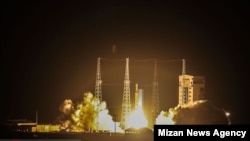For a fourth time Iran's mission to launch a satellite was aborted on Sunday when Simorgh, the rocket used for the launch, failed to lift Zafar into orbit. Zafar, which was anew Iranian satellite reportedly crashed in a rural area in southeast Iran where locals reported hearing eight massive explosions and saw a huge light in the sky.
Zafar (Victory) is an imaging satellite developed for dual purpose communication and remote sensing mission. Iran delayed the launch of Zafar on February 8 citing the need for making more preparations without offering further details.
The satellite was expected to be launched on the National Space Technology Day in Iran. The occasion coincides with the ten-day celebration of the anniversary of the Islamic Revolution during which Iran often unveils new missiles and technologies including achievements in its nuclear program.
According to NASA no Iranian satellite has reached orbit since Fajr which was launched in February 2015. Iran's first satellite, Omid (Hope) was deployed on February 2, 2009 by a rocket called Safir (Ambassador). In 2019 Iran launched Payam (Message), another satellite which also failed to reach the Earth's orbit. Payam was one the three attempts that failed in 2019, with one rocket exploding on the launch pad.
Zafar was launched by the Simorgh (Phoenix) launch vehicle from Imam Khomeini Sapaceport in Semnan Province, some 230 kilometers (145 miles) southeast of Tehran. Iranian officials said the failure resulted from the low speed of the Simorgh. According to NASA, the site has two main launch pads one of which is used by Simorgh and the other by Safir rockets. Simorgh is larger and more powerful than Safir.
The launch was shown live on Iranian state-run television.
NASA says Sunday's launch appeared to have failed during the second or third stage of the flight when Simorgh reached the 540 kilometer trajectory, about 1000 meters per second short of velocity required for reaching orbit.
The United States has accused Iran of using its satellite launch program as a cover for developing long-range ballistic missiles.
Debris found in Sistan and Baluchestan Province suspected to be parts of the satellite that failed to reach the orbit on Sunday.
On both February 8 and 9, cyberattacks were reported to have caused internet outages in Iran. Nariman Gharib, a UK-based journalist and Internet freedom activist in a tweet pointed out that the time of the cyberattacks which he described as "massive DDoS attacks" coincided with the day Iran intended to launch its Zafar satellite.
After the disappointment of the launch failure, the Minister of Communications, and Information Technology Mohammad-Javad Azari-Jahromi acknowledged the failure in a tweet but said the Revolutionary Guard had simultaneously tested "an advanced missile successfully" and in another tweet in English he said Iran is "unstoppable".
An official of the Governor's Office of the south-eastern Province of Zahedan on Monday said parts of the satellite that was launched on February 9 had crashed near Zahedan, the capital of Sistan and Baluchestan Province.
Social media users on Sunday evening reported eight massive explosion sounds and a huge bright light in Sarjangal and Chah Ahmad regions close to Zahedan.
Speaking to the Islamic Republic News Agency (IRNA) on Monday, the Security and Law Enforcement Deputy Governor of Sistan and Baluchestan Province Mohammad-Hadi Marashi, said authorities were investigating the source of the explosions and lights reported by the locals but also admitted that parts of the satellite have indeed been found where "in unpopulated areas close to Zahedan and citizens had no cause to worry".
Late on Sunday Azari-Jahromi claimed Zafar had landed in the Indian Ocean and promised to put another version of Zafar into orbit in June.





